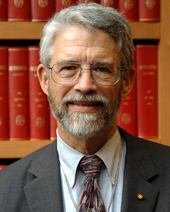Early life and education[edit]
Holdren was involved in the famous
Simon–Ehrlich wager in 1980. He, along with two other scientists helped
Paul R. Ehrlich establish the bet with
Julian Simon, in which they bet that the price of five key metals would be higher in 1990. The bet was centered around a disagreement concerning the future scarcity of resources in an increasingly polluted and heavily populated world. Ehrlich and Holdren lost the bet, when the price of metals had decreased by 1990.
[13]
Holdren served as one of President
Bill Clinton's science advisors (PCAST) from 1994 to 2001.
[2] Eight years later, President Barack Obama nominated Holdren for his current position as science advisor and Director of the Office of Science and Technology Policy in December 2008, and he was
confirmed on March 19, 2009, by a unanimous vote in the Senate.
[14][15][16][17] He testified to the nomination committee that he does not believe that government should have a role in determining optimal population size
[18] and that he never endorsed forced sterilization.
[19][20][21]
Publications[edit]
Overpopulation was an early concern and interest. In a 1969 article, Holdren and co-author
Paul R. Ehrlich argued, "if the population control measures are not initiated immediately, and effectively, all the technology man can bring to bear will not fend off the misery to come."
[22] In 1973, Holdren encouraged a decline in fertility to well below replacement in the United States, because "210 million now is too many and 280 million in 2040 is likely to be much too many."
[23] In 1977, Paul R. Ehrlich,
Anne H. Ehrlich, and Holdren co-authored the textbook
Ecoscience: Population, Resources, Environment; they discussed in this encyclopedic textbook the possible role of a wide variety of formulations to address human overpopulation. These included some extreme measures, none of which Ehrlichs and Holdren advocated,
[citation needed] such as forced sterilization, compulsory abortion, contraceptives in the food and water supply, reproductive licenses, and more. Holdren addressed this issue during his confirmation when he said he does not believe that determining
optimal population is a proper role of government. After his federal appointment, Holdren was criticized and questioned by activists about the book mentioning these subjects.
[20][24][25][26]
Other early publications include
Energy (1971),
Human Ecology (1973),
Energy in Transition (1980),
Earth and the Human Future (1986),
Strategic Defenses and the Future of the Arms Race(1987),
Building Global Security Through Cooperation (1990), and
Conversion of Military R&D (1998).
[27]

Holdren at a commercial human spaceflight press conference, 2010
Holdren is the author of over 200 articles and papers, and he has co-authored and co-edited some 20 books and book-length reports, including:
[27]
- Science in the White House. Science, May 2009, 567.[3]
- Policy for Energy Technology Innovation. Acting in Time on Energy Policy, (with Laura Diaz Anadon, Max H. Bazerman, David T. Ellwood, Kelly Sims Gallagher, William H. Hogan, Henry Lee, and Daniel Schrag), Brookings Institution Press, 2009.
- The Future of Climate Change Policy: The U.S.'s Last Chance to Lead. Scientific American 2008 Earth 3.0 Supplement. October 13, 2008, 20-21.[28]
- Convincing the Climate Change Skeptics. Boston Globe, August 4, 2008.[29]
- Ending the Energy Stalemate: A Bipartisan Strategy To Meet America's Energy Challenges. Presentation at the National Academies 2008 Energy Summit, Washington, D.C., March 14, 2008.[30]
- Global Climatic Disruption: Risks and Opportunities. Presentation at Investor Summit on Climate Risk, New York, February 14, 2008.[31]
- Meeting the Climate-Change Challenge. The John H. Chafee Memorial Lecture, National Council for Science and the Environment, Washington, D.C., January 17, 2008.[32]
Personal life[edit]
Holdren lives in
Falmouth, Massachusetts, with his wife, biologist Cheryl E. Holdren, with whom he has two children and five grandchildren.
[10]






No comments:
Post a Comment